

|
| DEUTSCHLAND | GERMANY |
| Bundesland: Nordrhein-Westfalen | North Rhine-Westphalia |
| Regierungsbezirk: Düsseldorf | |
| Stadt: Wuppertal |
Wuppertal is located at an elevation of 100–350 m in a bow of the river Wupper in the region Bergisches Land of North Rhine-Westfalia. The city has a population of about 361,300 (2005).
The city was founded on the 1st of August 1929 by a merger of the independent cities Barmen and Elberfeld, the towns Cronenberg, Ronsdorf and Vohwinkel, and the district Beyenburg of the former municipality of Lüttringhausen (today part of Remscheid). The new municipality was originally named Barmen-Elberfeld. After a referendum in 1930 the name was changed to Wuppertal. Even today the city has two larger urban centres (Barmen and Elberfeld) and five further town districts (Beyenburg, Cronenberg, Langerfeld, Ronsdorf and Vohwinkel) with a more provincial character.
The documented history of the various parts of the town goes back as far as the 11th century. Cronenberg was first mentioned in 1050, Barmen in 1070, followed by Elberfeld 1161, Schöller 1182, Ronsdorf 1246, Beyenburg 1298, Langerfeld 1304, Dönberg 1355 and Vohwinkel 1356. Elberfeld had a status similar to a town as early as 1444, although the formal town priviledges wer only granted in 1610 and 1623. When Elberfeld became of part of Prussia in 1815, the town became the seat of the Elberfeld district which also included Barmen and, after 1820 the municipalities of the former district Mettmann. Barmen for a long time consisted of several villages. In 1808 it obtained the formal status of a town. In 1861 Barmen and Elberfeld became independent cities and thus ceased to be part of the Elberfeld district; the remaining part of the district was renamed Mettmann (1929 Düsseldorf-Mettmann, 1975 again Mettmann).
At the end of the 19th century the region of Barmen and Elberfeld was the most important industrial region of the German Empire, at the time outperforming even the Ruhr region. One of the most important functions of the town was its role as a railroad hub and reloading-point for goods to a from the Ruhr region. Around 1900 small iron-working industry and textile industry became important factors for the town's economy. During the 1930s Wuppertal was one of the centres of the Nazi movement, but also, after 1934, of the Christian resistance movement. During World War II the town suffered severe damages and had to be rebuilt after the war. The modern extent of the municipality was reached after the incorporation of several of the neighbouring communities in 1975.
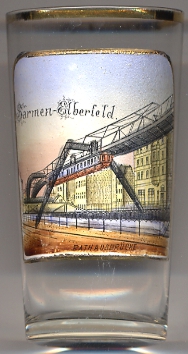
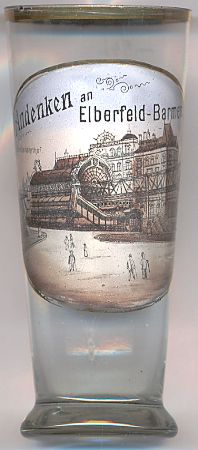 The best-known landmark of Wuppertal is without doubt the
The best-known landmark of Wuppertal is without doubt the
 Schwebebahn
Schwebebahn
The picture on glass no. 2769 [left] shows a view of the section
 Rathausbrücke
Rathausbrücke Schwebebahnhof
Schwebebahnhof
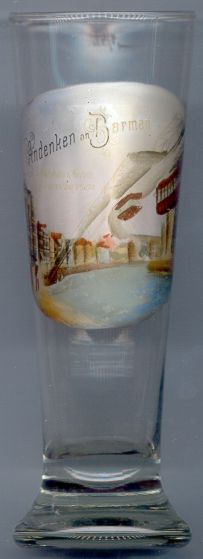
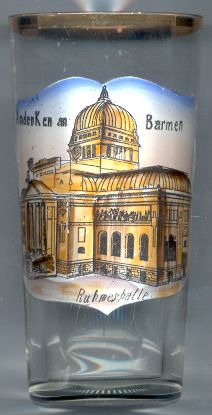
The  Ruhmeshalle (Hall of Fame) [left, no. 1861, and below, no. 4042: bottom picture] in Barmen
was meant to be a monument to the first two German Emperors, Wilhelm I and Friedrich III. The decision to build such a hall were made as early
as 1888. The competition that included 56 different designs was won by the Erdmann Hartig, director of the school of applied arts in Barmen.
The impressive Renaissance Revival building took there years of construction and was opened on 24th of August 1900 in a grand ceremony in the presence of
Emperor Wilhelm II. The building served as art gallery. During World War II it was destroyed in May 1943. In 1956 it was re-opened, without its
original larged domed roof, under the name Haus der Jugend.
Ruhmeshalle (Hall of Fame) [left, no. 1861, and below, no. 4042: bottom picture] in Barmen
was meant to be a monument to the first two German Emperors, Wilhelm I and Friedrich III. The decision to build such a hall were made as early
as 1888. The competition that included 56 different designs was won by the Erdmann Hartig, director of the school of applied arts in Barmen.
The impressive Renaissance Revival building took there years of construction and was opened on 24th of August 1900 in a grand ceremony in the presence of
Emperor Wilhelm II. The building served as art gallery. During World War II it was destroyed in May 1943. In 1956 it was re-opened, without its
original larged domed roof, under the name Haus der Jugend.
[https://de.wikipedia.org/wiki/Barmer_Ruhmeshalle]
![4042 Wuppertal [Barmen]: Stadthalle, Schwebebahn, Ruhmeshalle](glas4042v.jpg)
![4042 Wuppertal [Barmen]: Stadthalle, Schwebebahn, Ruhmeshalle](glas4042.jpg)
The  Barmer Stadthalle (Barmen Municipal Hall) [left, no. 4042: top left picture]
was built in 1895–1897 by the architect Erdmann Hartig. With a total area of 2,600 m², the town hall offered space for events for
1800 people. The town hall was destroyed in the air raids on Wuppertal on 30 May 1943. Reconstruction did not take place as the city wanted
to keep the Elberfeld municipal hall (see below) as an event building. After the war, the headquarters of the Barmer Ersatzkasse (Barmen Substitute Fund),
which is now home to the Wupperverband (Wupper Association), was built on the site .
Barmer Stadthalle (Barmen Municipal Hall) [left, no. 4042: top left picture]
was built in 1895–1897 by the architect Erdmann Hartig. With a total area of 2,600 m², the town hall offered space for events for
1800 people. The town hall was destroyed in the air raids on Wuppertal on 30 May 1943. Reconstruction did not take place as the city wanted
to keep the Elberfeld municipal hall (see below) as an event building. After the war, the headquarters of the Barmer Ersatzkasse (Barmen Substitute Fund),
which is now home to the Wupperverband (Wupper Association), was built on the site .
[https://de.wikipedia.org/wiki/Barmer_Stadthalle]
Glass no. 4042 [near left] is etched on the reverse side: Dem lieblichen 1. Tenor / 26.11.04 ('To the Lyric First Tenor / 26 November 1904').
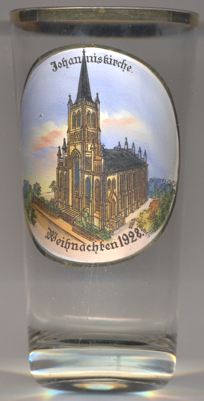
The Protestant  Johanniskirche [left, no. 3128] in Barmen
was built in 18969–1872 in Neo-Gothic style by the architect Hermann Cuno. The church was destroyed during the
Allied bomb raids of 30 May 1943. The ruins were finally torn down in 1953 to make way for a planned, but never
realised, road. In its place, a community centre including a hall for church services was built in 1957; in 1959
this building was named Paul-Gerhardt-Haus.
Johanniskirche [left, no. 3128] in Barmen
was built in 18969–1872 in Neo-Gothic style by the architect Hermann Cuno. The church was destroyed during the
Allied bomb raids of 30 May 1943. The ruins were finally torn down in 1953 to make way for a planned, but never
realised, road. In its place, a community centre including a hall for church services was built in 1957; in 1959
this building was named Paul-Gerhardt-Haus.
Glass no. 3128 is labeled Johanniskirche / Weihnachten 1928 ('Church of St. John / Christmas 1928').
[https://de.wikipedia.org/wiki/Johanniskirche_(Wuppertal)]
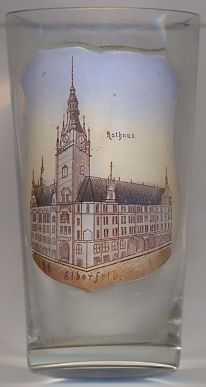 The
The  former city hall of Elberfeld [left, no. 2135] was built in 1828–1831 in Classicist style
by Johann Peter Cremer from Aachen.
In 1892, the Museum Society of Elberfeld (Elberfelder Museumsverein), which was founded in 1892, leased part of the building
for its collection. Over the years, more and more parts of the building became used for this purpose. One of the most
generous benefactors of the museum society was the Elberfeld bankers family Von der Heydt. Today, the whole building is
used as a museum, known since 1961 as the Von der Heydt Museum.
former city hall of Elberfeld [left, no. 2135] was built in 1828–1831 in Classicist style
by Johann Peter Cremer from Aachen.
In 1892, the Museum Society of Elberfeld (Elberfelder Museumsverein), which was founded in 1892, leased part of the building
for its collection. Over the years, more and more parts of the building became used for this purpose. One of the most
generous benefactors of the museum society was the Elberfeld bankers family Von der Heydt. Today, the whole building is
used as a museum, known since 1961 as the Von der Heydt Museum.
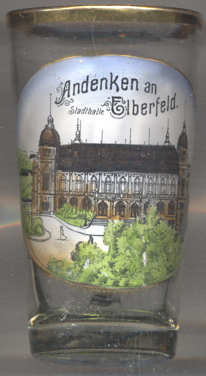 The
The  Stadthalle Wuppertal (official name: Historische Stadthalle am Johannisberg,
'historical Municipal Hall on Johannisberg') [near left, no. 3578] is one of the most important sights
of Wuppertal and, due to its unique acoustics, is also well-known as a concert and event venue. It was built in 1896–1897
in Renaissance revival style for the then independent city of Elberfeld. It was opened officially on 8 July 1900.
It is the only one of the historic theatre and concert venues in Wuppertal that were not destroyed in World War II
during the bomb raids of 1943. During a modernisation in 1957, stucco decorations were removed and guilded ceilings and
wall decorations were painted over. During a thorough renovation in 1992–1995, most of the historic decorative
elements were restored. The large hall has a seating capacity of about 1,550 and standing room for about 2,000. In addition,
there are five further, smaller halls.
Stadthalle Wuppertal (official name: Historische Stadthalle am Johannisberg,
'historical Municipal Hall on Johannisberg') [near left, no. 3578] is one of the most important sights
of Wuppertal and, due to its unique acoustics, is also well-known as a concert and event venue. It was built in 1896–1897
in Renaissance revival style for the then independent city of Elberfeld. It was opened officially on 8 July 1900.
It is the only one of the historic theatre and concert venues in Wuppertal that were not destroyed in World War II
during the bomb raids of 1943. During a modernisation in 1957, stucco decorations were removed and guilded ceilings and
wall decorations were painted over. During a thorough renovation in 1992–1995, most of the historic decorative
elements were restored. The large hall has a seating capacity of about 1,550 and standing room for about 2,000. In addition,
there are five further, smaller halls.
[https://de.wikipedia.org/wiki/Stadthalle_Wuppertal]
![[scale]](lineal.jpg)